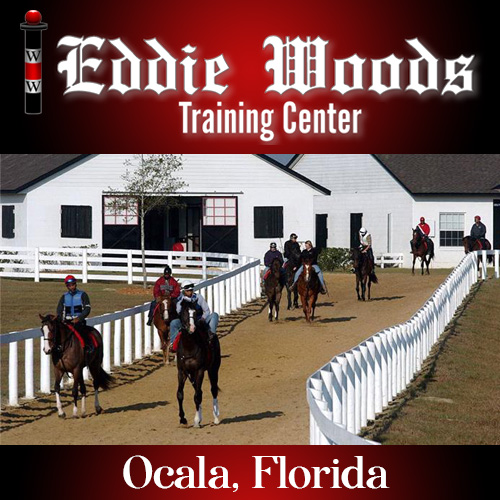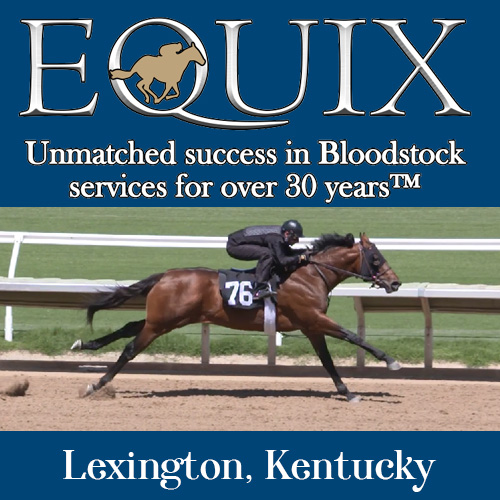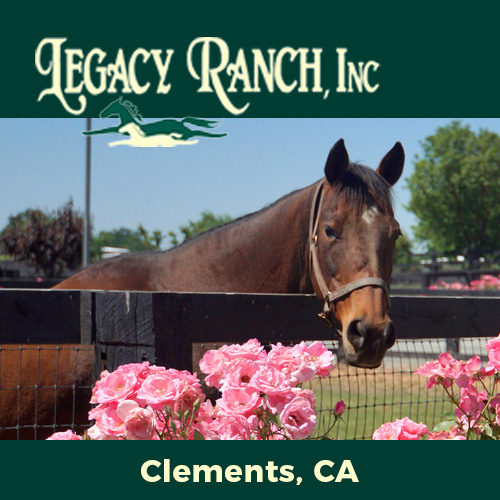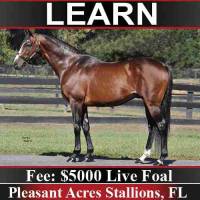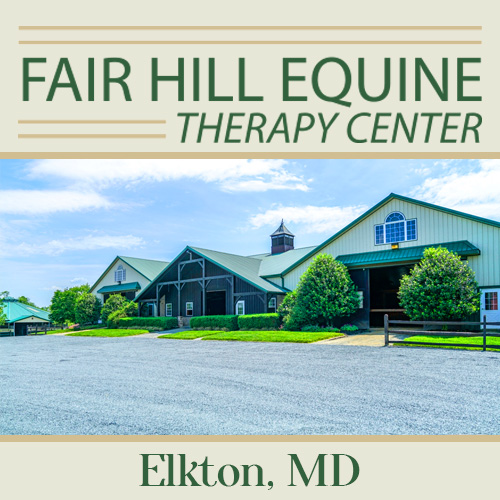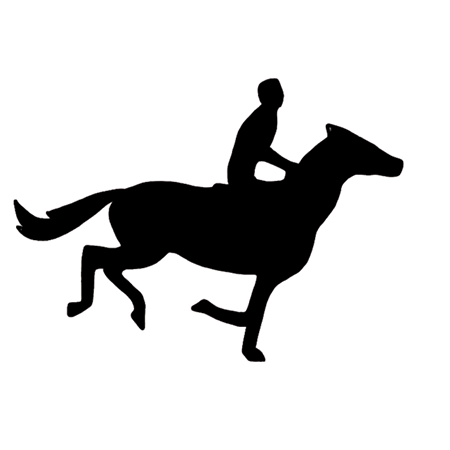Thoroughbred People's Equine Legends Series: Dr Fager
By Kimberly French
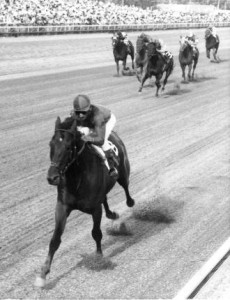 1968 was the year that a horse called Dr Fager accomplished a feat no other equine ever had before or likely ever will again.
1968 was the year that a horse called Dr Fager accomplished a feat no other equine ever had before or likely ever will again.
According to his Hall of Fame jockey Braulio Baeza and his just as illustrious conditioner John Nerud, the son of 1951 Santa Anita Derby victor Rough’n Tumble could “run a hole in the wind” and was the “fastest horse to ever live.” The record he established for a mile on August 24, 1968 at Arlington Park while toting 134 pounds has never been surpassed. That same year he was anointed as the sport’s champion Sprinter, champion Turf Horse, Horse of the Year and Handicap Horse of the Year. He was Dr. Fager and he left us far too soon, after succumbing to complications from colic at the age of 12.
Owned and bred by W.L. McKnight’s Tartan Farms and remembered for his rivalry with fellow champions Damascus, Buckpasser and his numerous track records, the highlight of Dr. Fager’s career for many continues to be the Washington Park Handicap at Arlington Park. Dr Fager hit the wire 10 lengths in front of his competitors while being geared down in an astonishing 1:32 1/5. It was a display of sheer brilliance and one of those occasions when humans can witness true perfection. Although the video quality may not be as high tech as we have grown accustomed to, Dr. Fager’s trip around the Chicago oval that day still sends chills up the spine and brings a tear to the eye.
It can be viewed here https://www.youtube.com/watch?v=6wVBNbmcaAE.
Called by Phil Georgeff, the “voice of Chicago,” who is also enshrined in the Guinness Book of World Records for the most races ever announced, (96,131), this engagement was contested after a week of extremely hot weather and the track was classified as “bone dry.” Dr. Fager was coming into the event off an eight length romp in the Whitney Stakes where he set a record in 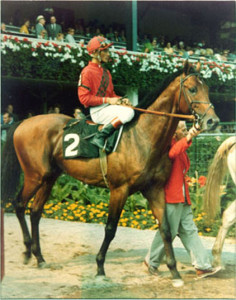 New York State by going to the gate as the overwhelming 1-20 public selection. No horse had ever been bet down that low and this was despite giving away 18 pounds to his rivals.
New York State by going to the gate as the overwhelming 1-20 public selection. No horse had ever been bet down that low and this was despite giving away 18 pounds to his rivals.
The great Nerud, the Doctor’s trainer and co-owner, said the way the horse came into the paddock that day he knew he was going to run in spectacular fashion and many people felt the horse could actually have run two full seconds faster if he had been asked. His pilot on that historic day, Baeza, confirms that assessment.
“I was easing him up at the quarter pole,” he recalled. “I looked back and no one was coming. If I knew he was setting the world record, all I had to do was chirp to him and he would’ve lowered the record even more. His speed was deceiving because he had such a long, smooth stride, he ate up so much ground.”
More than two decades after the race was in the history books, for venerated turf scribe Neil Milbert it was still fresh in his mind.
“They ran at Dr. Fager in sizzling relays. First Hedevar, then Angelico and Kentucky Sherry, next R. Thomas and finally Racing Room,” he wrote in a 1989 article in the Chicago Tribune. “It was to no avail. Dr. Fager was sixth at the quarter-mile call and second at the half, a head behind R. Thomas. Moving with a rush while still being held under restraint by jockey Braulio Baeza, he took command leaving the backstretch and rocketed away from his adversaries. Based on the Daily Racing Form’s chart of the race, he won “with something left.” The fractions were :22 4/5 by Angelico for the quarter, :44 by R. Thomas for the half and 1:07 3/5 by Dr. Fager for three-quarters.”
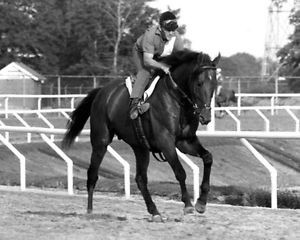 Award winning journalist Steve Haskin of the Blood Horse, who also wrote a book on the horse, describes his personal impression of the race in a blogpost from 2013.
Award winning journalist Steve Haskin of the Blood Horse, who also wrote a book on the horse, describes his personal impression of the race in a blogpost from 2013.
“It is safe to say that in his victory in the 1968 Washington Park Handicap, setting a world record mile of 1:32 1/5 under 134 pounds and winning by 10 lengths, no horse has ever run that fast, that easily and won by that far, as jockey Braulio Baeza never moved a muscle on him the entire length of the stretch,” he wrote. “The sight of Baeza sitting motionless, with Dr. Fager’s long mane blowing in his face, truly was a sight to behold. Many horsemen watching the race firmly believed that had Baeza even asked him slightly, Dr. Fager would have easily run the mile in 1:31 and change, maybe even faster; that’s how easily he won. And he did it giving the runner-up, the classy Racing Room, 18 pounds. In that race, in which he went the half in :44 flat and six furlongs in 1:07 3/5, he ran his second quarter in an unheard of :20 3/5, which was believed to be the fastest quarter-mile fraction ever run in a non-sprint race and the fastest quarter within the body of a race at any distance.”
Although he accomplished phenomenal things in his career with an astonishing amount of weight on his back, Dr. Fager, who’s younger sister Ta Wee is also enshrined in the Hall of Fame and was named champion Sprinter in 1969 and 1970, closed his time out on the racetrack in style. Saddled with a 139 impost and performing over a surface that was deep and cuppy from it being winterized, Dr. Fager captured his second edition of the seven furlong Vosburgh Handicap in a blistering 1:20 1/5. It demolished Rose Net’s track record by a full second and was just 1/5 of a second off the world record.
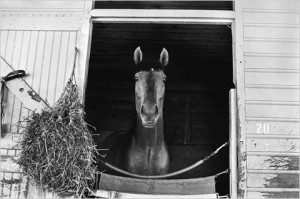 “The last time he ran, he carried 139 pounds and he ran the 7 furlongs in 1:20,” Baeza said. “I knew it was his last race, so I didn’t want to abuse him. No one was coming so I relaxed on him. I had the brakes on from the quarter.”
“The last time he ran, he carried 139 pounds and he ran the 7 furlongs in 1:20,” Baeza said. “I knew it was his last race, so I didn’t want to abuse him. No one was coming so I relaxed on him. I had the brakes on from the quarter.”
Nerud, who also played a role in Dr. Fager’s breeding, certainly knew what quality horseflesh consisted of and never pulled any punches when asked about this great champion.
“Dr. Fager was the fastest horse I ever saw,” he said. “There was never a horse in the world who could run with him and win. He just kept that long stride going, he just kept laying on you, and could go the first three-quarters in [1:07]. He didn’t want to be hit or abused. He just wanted to be left alone to do his own thing. And he’d do the best he could.”
It appears Dr. Fager would have been just as prolific in the breeding shed as he was on the racetrack. After retiring with a record of 22-18-2-1 and with earnings of just over $1 million, the horse was only defeated by three other rivals. Two of them, Damascus and Buckpasser are in the Hall of Fame, and they competed against him with “rabbits” that were sent out to soften Dr Fager up.
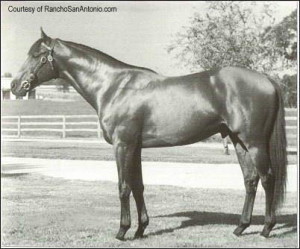 As a stallion, Dr. Fager proved just as spectacular. He led the national sire list in North America the year after his death and sired 1975 Juvenile Champion filly Dearly Precious, 1978 co-champion Sprinter Dr. Patches, Tree of Knowledge and L’Alezane. He also became known as an outstanding broodmare sire. Although his life was cut short, Dr. Fager, ranked sixth in the Blood-Horse’s top 100 Thoroughbreds of the 20th Century, is felt by many historians to have been the best horse ever to race in North America. His memory remains vibrant today.
As a stallion, Dr. Fager proved just as spectacular. He led the national sire list in North America the year after his death and sired 1975 Juvenile Champion filly Dearly Precious, 1978 co-champion Sprinter Dr. Patches, Tree of Knowledge and L’Alezane. He also became known as an outstanding broodmare sire. Although his life was cut short, Dr. Fager, ranked sixth in the Blood-Horse’s top 100 Thoroughbreds of the 20th Century, is felt by many historians to have been the best horse ever to race in North America. His memory remains vibrant today.
“Tartan Farm is long gone, but there is one section of hallowed ground that has remained untouched,” Haskin wrote. “Atop a hill, overlooking the serenity of Lake Ta Wee, named after the Doctor’s sister, is the farm’s old cemetery. There, behind a cedar tree and shaded by two oak trees are the headstones of the horses that helped build the Tartan empire. Among them is the grave of Dr. Fager, whose spirit still touches all those who were privileged to witness his greatness.
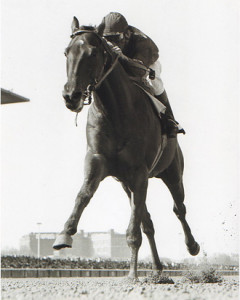 “As I concluded in my book, perhaps the late racing writer, David Alexander, described Dr. Fager best when he wrote: ‘The memory of him is the memory of the wind. I shall remember the brilliant Dr. Fager like a sudden shaft of sunlight on a darkening day.’”
“As I concluded in my book, perhaps the late racing writer, David Alexander, described Dr. Fager best when he wrote: ‘The memory of him is the memory of the wind. I shall remember the brilliant Dr. Fager like a sudden shaft of sunlight on a darkening day.’”
